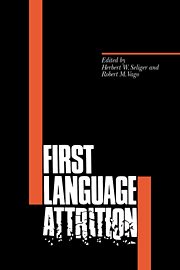Book contents
- Frontmatter
- Contents
- List of figures
- List of tables
- List of contributors
- Acknowledgment
- Part I Survey studies
- Part II Group studies
- Part III Case studies
- 12 Morphological disintegration and reconstruction in first language attrition
- 13 Assessing first language vulnerability to attrition
- 14 Compensatory strategies of child first language attrition
- 15 Language attrition, reduced redundancy, and creativity
- 16 Paradigmatic regularity in first language attrition
- Index
15 - Language attrition, reduced redundancy, and creativity
Published online by Cambridge University Press: 14 January 2010
- Frontmatter
- Contents
- List of figures
- List of tables
- List of contributors
- Acknowledgment
- Part I Survey studies
- Part II Group studies
- Part III Case studies
- 12 Morphological disintegration and reconstruction in first language attrition
- 13 Assessing first language vulnerability to attrition
- 14 Compensatory strategies of child first language attrition
- 15 Language attrition, reduced redundancy, and creativity
- 16 Paradigmatic regularity in first language attrition
- Index
Summary
Introduction
First language attrition is a ubiquitous phenomenon found wherever there is bilingualism. The phenomenon raises a number of interesting questions for the linguist and the psycholinguist. For the linguist, language attrition, like second language acquisition, provides interesting evidence about the relationships of grammars in contact, be it phonological (Vago, this volume), morphological (Kaufman & Aronoff, this volume), morphosyntactic (Seliger 1986) or syntactic, as in the study to be discussed in this chapter. The phenomenon of language attrition also allows hypotheses about putative language universals and markedness conditions to be tested across languages (Seliger & Vago, this volume).
For the psycholinguist, language attrition raises questions about the relative permanence of acquisition itself, about the cognitive conditions necessary to maintain language in the context of bilingualism, and about the conditions which lead to the dissolution or attrition of language abilities within normal populations of mature speakers as opposed to polyglot aphasics.
Both language attrition and language acquisition must explain how generalizations and overgeneralizations are learned and then unlearned in the gradual evolution of grammars. In both situations, rule constraints and categorization features may be underextended or overextended until the process of acquisition or loss has reached its maximum level of development. In the one case, L1 acquisition, that evolution is supposed to lead to the final state grammar used by the adult native speaker. In the case of first language attrition in the context of bilingualism, that process of unlearning and evolution can lead to reduction in some areas of the grammar and the creation of new forms in others in the first language while the second language may continue to develop.
- Type
- Chapter
- Information
- First Language Attrition , pp. 227 - 240Publisher: Cambridge University PressPrint publication year: 1991
- 31
- Cited by



